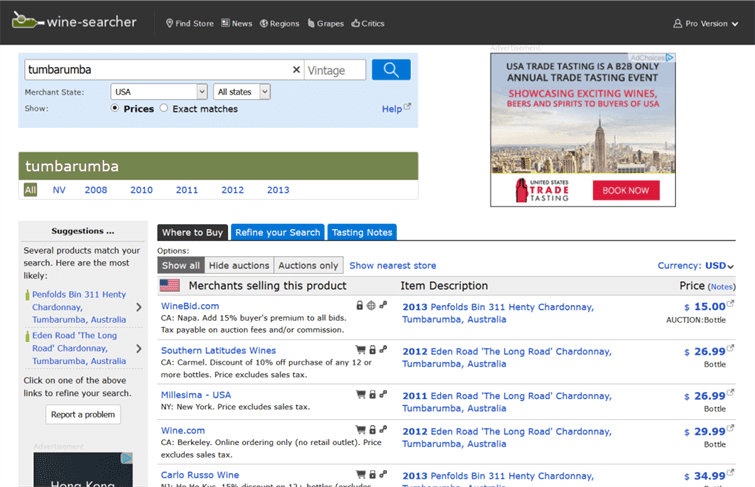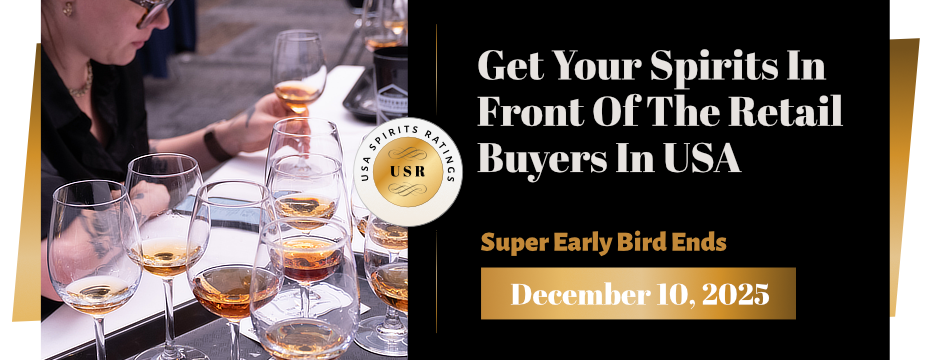Sommeliers Choice Awards 2025 Winners
How to Disrupt the US Drinks Market With Non-Traditional Marketing
Practical advice on 4 strategies to capitalize on emerging trends in the American wine and spirits business:

In conversation with Steve Raye, President of PR and marketing firm Bevology Inc that helps brands enter and grow in the US market, we discover how young millennials are affecting and changing the wine market with current behavioral trends and how to follow suit.
Young millennials are completely changing the rules of the marketing game for wine importers and distributors. What are these changing consumer trends?
• They are driving a trade-up to higher priced wines, with the most growth in the $12 - $15 and $15 - $20 segments.
• They behave very differently from previous generations
– Seek out what’s new and different (to them)
• Moscato, Prosecco, Red Blends
– Very open to imported brands, and particularly New World wines.
• They don’t get their information from magazines, they get it on their smartphones and from online resources and their social networks.
As opposed to the common strain of thought, millennials are not focused on entry-level wines. They want to drink good quality wine that is rated well and are prepared to pay higher prices for it. This is a sweet spot for producers where they can really make some margins.
The encouraging news is that millennials are a lot more willing to try and experiment with new brands and varietals. Gone are the days when a supplier or an importer with a relatively unknown product stood little or no chance of gaining traction in the U.S. market. That’s because millennials don’t put as much stock in the value of “experts” – they’d rather trust the opinions of their friends and peers on social media. And that also makes them much more accepting of wines like Moscato, Prosecco and red blends that experts may not cover. If their friends are “liking” it on Facebook, they might just consider buying it.
Now that they have become the largest wine-consuming cohort in the world, these 77 million millennials are forcing importers and distributors to re-think their traditional marketing strategies.
As Steve Raye suggests, the way young millennials learn about wine and then purchase this wine is fundamentally different from how Baby Boomers learn about wine and then purchase it. That’s disconcerting for long-time industry veterans, who may be scrambling to adjust to the new innovations of the social media and mobile worlds, but also exhilarating.
Changing Consumer Dynamics

Who is swaying millennials’ buying decisions and what are the real numbers we are looking at?
The influencers are changing
• They seek “authoritative” information online at sites and on apps like Wine-Searcher, Vivino, Wine4me, Snooth, Hello Vino, Delectable et al.
• And personal recommendations and evaluations through social media
• They do not subscribe to magazines or pay for access to scores on WineSpectator.com
And the scale is changing as well
• Wine Spectator – 400,000; Wine Enthusiast – 177,000; Wine Advocate – 48,000
• Wine-Searcher gets 3 million unique visitors per month, and their data feeds many other sites. Vivino has 10.9 million users
The new market influencers are websites and rather than magazines and their ratings. Millennials are getting their ideas and recommendations from smartphones, online communities of wine enthusiasts, and social networks. So, if your wine is not showing up in their Facebook newsfeed, they’re probably not hearing about it.
Instead of advertising in the Wine Spectator magazine, for example, producers should be ramping up their presence on social media. Instead of relying on retail strategies designed with individual stores in mind, they should be experimenting with new forms of e-commerce, including “delivery within one hour” models. And they should be actively partnering with popular wine apps, such as Vivino, as a way of reaching a much broader target population of wine drinkers.
Why the big jump in numbers? That’s because the target market for wine buyers has expanded exponentially. To put these numbers into perspective, in a space of 2 weeks, the number of users on Vivino basically jumped more than the combined circulation of the leading wine magazines in the USA. This is where suppliers need to be paying attention, as this is where consumers are going to make their purchases.

In the early days of print advertising, the adage of “I know half my advertising doesn’t work..I just don’t know which half” was commonly accepted. No one really knew what their advertising dollars was getting them and they were ok with it.
Move over to the scenario in the last 5 years. The popularity of the new wine apps means that you have a chance to reach a consumer at the point of sale. Now, listing your product on one of these apps or websites means that the consumer is actively seeking more information about your brand. This is much more concrete than relying on a shopper recognizing your brand as they are leafing through a magazine, then recollecting it’s name when they go to a store, chancing upon it and making a purchase.
In the current scenario, a customer literally has the app open in one hand, and the bottle of your wine in the other hand. If they look for information on a wine on Vivino, they want to see some information about reviews, tasting notes, or awards. If they don’t see it, they are going to move on. Otherwise, you have a sale.
Adapt or Become Irrelevant
1. Social Media Strategies:
Engage on Social Media and monitor, measure and manage the conversations
Reaching wine buyers on social media doesn’t have to be difficult, as long as you’re willing to embrace some non-traditional marketing strategies. According to Raye, it’s best to pick 1-2 social media platforms and do them really well. For some wine importers, that might mean Facebook and Instagram, while for others it might be Twitter and Pinterest.
Stop shouting and start talking –
Social media has also involved from its early days, where it no longer works to “shout” by continually posting promotional content about one’s brands and companies. Rather, one needs to “talk” by engaging and having conversations and then monitoring and measuring the effect of these.
• Build a community
• Empower/encourage them to share and tell your story to their friends in their words
The best part of tapping into social media is all the network effects that are possible. A knowledgeable wine fan who tells just 10 friends about a new wine on social media can be assured that those 10 friends will tell another 10 friends, who will tell another 10 friends. To make sure you can capture this ripple effect though, you have to realize that images and video are the way people tell stories these days. Posts should not be promotional 100% of the time, followers will soon lose interest and walk away. Content has to be engaging and entertaining, humor is interesting. Be original and bring something new to the party.
Facebook is now very much a “pay-to-play” environment, in which putting out regular updates on the social network will never gain any true traction unless you have some budget behind them to promote those posts.
Think of Social Media as free market research. Use statistics provided by Google Analytics and Facebook Insights to know the results of your social media activity and generate insights based on this. You will be able to devise better content and social strategies based on this information. Apps like Vintalk feed in this data and tie in to Delectable so one can run a social media campaign and see real results from it.

2. Content is King, Context is Queen
Take responsibility and control of how your brand is presented
Content Population Strategy
a. Publicity that exists forever on the web and attracts visitors at the precise moment in time when they are most interested in the subject.

• 7,823% more views as archived file than when it was originally posted.
• And they spent twice as much time viewing the content
Why this is important: Reaching people at the precise moment in time when they’re searching for this information
Content Population is Evergreen and Grows over time.

• 275 registered for live webinar
• 5,591 views since then
b. Leverage the authority and authenticity of trusted sites.

Think about partnering with wine websites and wine apps that have already aggregated a huge audience rather than attempting to build a new community from scratch. Wine apps like Vivino are now extraordinarily powerful, holding the key to getting the word out about your wine to millions of people. At the very least, you need to claim your brand(s) on these platforms, where you can provide tasting notes, reviews, food pairing information and other commentary. It’s almost like providing a veteran sommelier at the beck and call of any millennial.
c. Content in the Right Context Moves Boxes
The big takeaway here is that the right content in the right context moves boxes. This is true for any wine, even one that is unknown or unfamiliar to wine buyers. So don’t be afraid to experiment, says Raye.

The store K&L Wine Merchants in terms of retail space is a relatively small store based in Califronia. Look to it’s online presence though and you will find that it has a mammoth consumer-base, being the third largest e-commerce retailer in the U.S. They feature a regular wine and spirits blog and interviewed a relatively unknown spirits brand on it. This was circulated via newsletter to their email to opt-in database consisting of 90,000 active shoppers. Within a matter of hours, they sold out an initial 11 cases of inventory, asked for replacement inventory in two days which sold out again. A volume of 100 cases was generated in 4 months and the store continues to promote and sell this product that no one had heard of and most importantly from a category that is mostly unknown to consumers. The brand since then has gained popularity across the state. (Relevant read: How to create targetted distribution).
3. Retail is evolving

Delivery-within-an-hour services, Apps
In terms of selling more wines to an increasing number of customers, it’s impossible to overstate the importance of coming up with a modern e-commerce strategy. One approach is to partner with a “delivery within 1 hour” provider like Mini Bar Delivery, Drizly, Drync or Saucey. These apps enable companies to geo-target to particular states, cities or even neighborhoods where they want to focus on sales.
Listing your wines, spirits or beers on these apps is also a great tool to drive retail distribution and support the wholesaler. The retailer sees these as an active sales channel and is therefore happy to participate and many a times the margin they make on a sale through an app is far greater than what they make on a walk-in sale. The retailer has now been turned into a motivated e-commerce partner.
4. Retail store trading areas are no longer barriers

E-commerce becomes a strategic tool. The real driver of sales performance is being able to partner with e-commerce sites. E-commerce websites also present consumers with a vast selection of products and options. While a retail store may only stock one or a few SKUs from a particular winery, the shopper will be able to see the entire range of wines from that winery, choose to buy it from a location they want at the price they want and have it shipped to their house by the next day. Presented with this much convenience, it is not hard to see why millennials are incessant online shoppers.
For wine sellers, the big perk is that people who purchase online typically buy 3 times the amount of wine that people who shop in retail stores. Since a shopper is paying shipping charges, rather than purchasing a single bottle they would add a few more to the cart to make the shipping charges feasible.
Take advantage of sites like Wine-Searcher.com, where you can make a huge difference in how people perceive your wine by adding ratings, reviews, tasting notes and, most importantly, a guide of where to buy the wine. For wines that are imported into the US, wine.com is an important platform as 53% of wines bought here are from outside the U.S.
The major win for producers is that they can sell in states where they don’t hold licenses or work with physical wholesalers as the online merchant has those licenses. This translates into a rapid growth strategy that one could previously have only dreamed of.
Partnering with an e-commerce platform consummates all the other efforts you have put in towards building your brand, from PR to reviews, ratings, winemaker tours, tastings and advertising.
E-Commerce Optimization
When your products are listed on an e-commerce platform, ensure that you have provided all the relevant information for it. This includes a bottle photo, tasting notes, technical notes, food pairing notes and information on where to buy the product. This is the equivalent of a full-dressed product sitting on a retail shelf with a trained and knowledge sales staff standing by to help with information.
When a shopper is looking around, they should have all the information about your brand available at their fingertips as this will help them make a purchase.
Before:

After:

These sweeping new changes in how people learn about wine, decide what to buy, and actually buy differ fundamentally from the behaviors and preferences of previous generations. But with a committed strategy that is focused on engagement, it’s possible to post some impressive results. You just have to be willing to embrace some non-traditional marketing strategies.





















